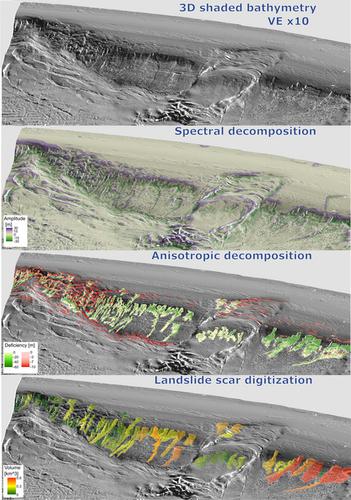当前位置:
X-MOL 学术
›
Basin Res.
›
论文详情
Our official English website, www.x-mol.net, welcomes your
feedback! (Note: you will need to create a separate account there.)
Semi‐automated bathymetric spectral decomposition delineates the impact of mass wasting on the morphological evolution of the continental slope, offshore Israel
Basin Research ( IF 2.8 ) Pub Date : 2019-11-25 , DOI: 10.1111/bre.12420 Omri Gadol 1, 2 , Gideon Tibor 1, 3 , Uri Brink 1, 4 , John K. Hall 5 , Gavrielle Groves‐Gidney 6, 7 , Gideon Bar‐Am 8 , Christian Hübscher 9 , Yizhaq Makovsky 1, 2
Basin Research ( IF 2.8 ) Pub Date : 2019-11-25 , DOI: 10.1111/bre.12420 Omri Gadol 1, 2 , Gideon Tibor 1, 3 , Uri Brink 1, 4 , John K. Hall 5 , Gavrielle Groves‐Gidney 6, 7 , Gideon Bar‐Am 8 , Christian Hübscher 9 , Yizhaq Makovsky 1, 2
Affiliation

|
[The southeastern mediterranean continental slope bathymetry is impacted by interleaved imprints of mass transport processes. These are delineated, classified and mapped through semi‐automatic bathymetric spectral decomposition, appraising their role in sediments bypassing and maintenance of a long‐term shelf‐to‐basin equilibrium profile. , Abstract Understanding continental‐slope morphological evolution is essential for predicting basin deposition. However, separating the imprints and chronology of different seafloor shaping processes is difficult. This study explores the utility of bathymetric spectral decomposition for separating and characterizing the variety of interleaved seafloor imprints of mass wasting, and clarifying their role in the morphological evolution of the southeastern Mediterranean Sea passive‐margin slope. Bathymetric spectral decomposition, integrated with interpretation of seismic profiles, highlights the long‐term shape of the slope and separates the observed mass transport elements into several genetic groups: (1) a series of ~25 km wide, now‐buried slide scars and lobes; (2) slope‐parallel bathymetric scarps representing shallow faults; (3) slope‐perpendicular, open slope slide scars; (4) bathymetric roughness representing debris lobes; (5) slope‐confined gullies. Our results provide a multi‐scale view of the interplay between sediment transport, mass transport and shallow faulting in the evolution of the slope morphology. The base of the slope and focused disturbances are controlled by ~1 km deep salt retreat, and mimic the Messinian base of slope. The top of the open‐slope is delimited by faults, accommodating internal collapse of the margin. The now‐buried slides were slope‐confined and presumably cohesive, and mostly nucleated along the upper‐slope faults. Sediment accumulations, infilling the now‐buried scars, generated more recent open‐slope slides. These latter slides transported ~10 km3 of sediments, depositing a significant fraction (~3 m in average) of the sediments along the base of the studied slope during the past < 50 ka. South to north decrease in the volume of the open‐slope slides highlight their role in counterbalancing the northwards diminishing sediment supply and helping to maintain a long‐term steady‐state bathymetric profile. The latest phase slope‐confined gullies were presumably created by channelling of bottom currents into slide‐scar depressions, possibly establishing incipient canyon headword erosion.]
中文翻译:

半自动测深光谱分解描绘了质量浪费对以色列近海大陆坡形态演变的影响
[地中海东南部大陆坡的水深测量受到大规模运输过程交错印记的影响。这些是通过半自动测深光谱分解来描绘、分类和绘制的,评估它们在绕过沉积物和维持长期陆架到盆地平衡剖面中的作用。, 摘要 了解大陆坡形态演化对于预测盆地沉积至关重要。然而,区分不同海底成形过程的印记和年代是很困难的。本研究探索了测深光谱分解在分离和表征质量浪费的各种交错海底印记方面的效用,并阐明了它们在地中海东南部被动边缘斜坡形态演变中的作用。测深光谱分解与地震剖面的解释相结合,突出了斜坡的长期形状,并将观察到的传质元素分为几个遗传组:(1)一系列约 25 公里宽的、现已掩埋的滑痕和裂片; (2) 代表浅断层的斜坡平行测深陡坡;(3) 斜坡垂直、开放斜坡滑痕;(4) 代表碎片裂片的测深粗糙度;(5) 边坡限制沟壑。我们的研究结果提供了沉积物输送、质量输送和浅层断层在斜坡形态演化过程中相互作用的多尺度视图。斜坡底部和集中扰动由约 1 公里深的盐退控制,并模仿墨西拿斜坡底部。开放斜坡的顶部被断层界定,适应边缘的内部坍塌。现在埋藏的滑坡受斜坡限制,推测具有粘性,并且大部分沿上斜坡断层成核。沉积物堆积,填充现在埋藏的疤痕,产生了最近的开放斜坡滑坡。后面的这些滑坡输送了约 10 km3 的沉积物,在过去 < 50 ka 期间沿着所研究斜坡的底部沉积了相当一部分(平均约 3 m)的沉积物。开放斜坡滑坡的体积从南到北的减少突出了它们在平衡向北减少的沉积物供应和帮助维持长期稳态测深剖面方面的作用。最新阶段的斜坡限制冲沟可能是通过将底部水流引导到滑痕洼地而形成的,可能建立了初期的峡谷词条侵蚀。] 且大多沿上斜坡断层成核。沉积物堆积,填充现在埋藏的疤痕,产生了最近的开放斜坡滑坡。后面的这些滑坡输送了约 10 km3 的沉积物,在过去 < 50 ka 期间沿着所研究斜坡的底部沉积了相当一部分(平均约 3 m)的沉积物。开放斜坡滑坡的体积从南到北的减少突出了它们在平衡向北减少的沉积物供应和帮助维持长期稳态测深剖面方面的作用。最新阶段的斜坡限制冲沟可能是通过将底部水流引导到滑痕洼地而形成的,可能建立了初期的峡谷词条侵蚀。] 且大多沿上斜坡断层成核。沉积物堆积,填充现在埋藏的疤痕,产生了最近的开放斜坡滑坡。后面的这些滑坡输送了约 10 km3 的沉积物,在过去 < 50 ka 期间沿着所研究斜坡的底部沉积了相当一部分(平均约 3 m)的沉积物。开放斜坡滑坡的体积从南到北的减少突出了它们在平衡向北减少的沉积物供应和帮助维持长期稳态测深剖面方面的作用。最新阶段的斜坡限制冲沟可能是通过将底部水流引导到滑痕洼地而形成的,可能建立了初期的峡谷词条侵蚀。] 后面这些滑坡输送了约 10 km3 的沉积物,在过去 < 50 ka 期间沿着所研究斜坡的底部沉积了相当一部分(平均约 3 m)的沉积物。开放斜坡滑坡的体积从南到北的减少突出了它们在平衡向北减少的沉积物供应和帮助维持长期稳态测深剖面方面的作用。最新阶段的斜坡限制冲沟可能是通过将底部水流引导到滑痕洼地而形成的,可能建立了初期的峡谷词条侵蚀。] 后面的这些滑坡输送了约 10 km3 的沉积物,在过去 < 50 ka 期间沿着所研究斜坡的底部沉积了相当一部分(平均约 3 m)的沉积物。开放斜坡滑坡的体积从南到北的减少突出了它们在平衡向北减少的沉积物供应和帮助维持长期稳态测深剖面方面的作用。最新阶段的斜坡限制冲沟可能是通过将底部水流引导到滑痕洼地而形成的,可能建立了初期的峡谷词条侵蚀。] 开放斜坡滑坡的体积从南到北的减少突出了它们在平衡向北减少的沉积物供应和帮助保持长期稳态测深剖面方面的作用。最新阶段的斜坡限制冲沟可能是通过将底部水流引导到滑痕洼地而形成的,可能建立了初期的峡谷词条侵蚀。] 开放斜坡滑坡的体积从南到北的减少突出了它们在平衡向北减少的沉积物供应和帮助维持长期稳态测深剖面方面的作用。最新阶段的斜坡限制冲沟可能是通过将底部水流引导到滑痕洼地而形成的,可能建立了初期的峡谷词条侵蚀。]
更新日期:2019-11-25
中文翻译:

半自动测深光谱分解描绘了质量浪费对以色列近海大陆坡形态演变的影响
[地中海东南部大陆坡的水深测量受到大规模运输过程交错印记的影响。这些是通过半自动测深光谱分解来描绘、分类和绘制的,评估它们在绕过沉积物和维持长期陆架到盆地平衡剖面中的作用。, 摘要 了解大陆坡形态演化对于预测盆地沉积至关重要。然而,区分不同海底成形过程的印记和年代是很困难的。本研究探索了测深光谱分解在分离和表征质量浪费的各种交错海底印记方面的效用,并阐明了它们在地中海东南部被动边缘斜坡形态演变中的作用。测深光谱分解与地震剖面的解释相结合,突出了斜坡的长期形状,并将观察到的传质元素分为几个遗传组:(1)一系列约 25 公里宽的、现已掩埋的滑痕和裂片; (2) 代表浅断层的斜坡平行测深陡坡;(3) 斜坡垂直、开放斜坡滑痕;(4) 代表碎片裂片的测深粗糙度;(5) 边坡限制沟壑。我们的研究结果提供了沉积物输送、质量输送和浅层断层在斜坡形态演化过程中相互作用的多尺度视图。斜坡底部和集中扰动由约 1 公里深的盐退控制,并模仿墨西拿斜坡底部。开放斜坡的顶部被断层界定,适应边缘的内部坍塌。现在埋藏的滑坡受斜坡限制,推测具有粘性,并且大部分沿上斜坡断层成核。沉积物堆积,填充现在埋藏的疤痕,产生了最近的开放斜坡滑坡。后面的这些滑坡输送了约 10 km3 的沉积物,在过去 < 50 ka 期间沿着所研究斜坡的底部沉积了相当一部分(平均约 3 m)的沉积物。开放斜坡滑坡的体积从南到北的减少突出了它们在平衡向北减少的沉积物供应和帮助维持长期稳态测深剖面方面的作用。最新阶段的斜坡限制冲沟可能是通过将底部水流引导到滑痕洼地而形成的,可能建立了初期的峡谷词条侵蚀。] 且大多沿上斜坡断层成核。沉积物堆积,填充现在埋藏的疤痕,产生了最近的开放斜坡滑坡。后面的这些滑坡输送了约 10 km3 的沉积物,在过去 < 50 ka 期间沿着所研究斜坡的底部沉积了相当一部分(平均约 3 m)的沉积物。开放斜坡滑坡的体积从南到北的减少突出了它们在平衡向北减少的沉积物供应和帮助维持长期稳态测深剖面方面的作用。最新阶段的斜坡限制冲沟可能是通过将底部水流引导到滑痕洼地而形成的,可能建立了初期的峡谷词条侵蚀。] 且大多沿上斜坡断层成核。沉积物堆积,填充现在埋藏的疤痕,产生了最近的开放斜坡滑坡。后面的这些滑坡输送了约 10 km3 的沉积物,在过去 < 50 ka 期间沿着所研究斜坡的底部沉积了相当一部分(平均约 3 m)的沉积物。开放斜坡滑坡的体积从南到北的减少突出了它们在平衡向北减少的沉积物供应和帮助维持长期稳态测深剖面方面的作用。最新阶段的斜坡限制冲沟可能是通过将底部水流引导到滑痕洼地而形成的,可能建立了初期的峡谷词条侵蚀。] 后面这些滑坡输送了约 10 km3 的沉积物,在过去 < 50 ka 期间沿着所研究斜坡的底部沉积了相当一部分(平均约 3 m)的沉积物。开放斜坡滑坡的体积从南到北的减少突出了它们在平衡向北减少的沉积物供应和帮助维持长期稳态测深剖面方面的作用。最新阶段的斜坡限制冲沟可能是通过将底部水流引导到滑痕洼地而形成的,可能建立了初期的峡谷词条侵蚀。] 后面的这些滑坡输送了约 10 km3 的沉积物,在过去 < 50 ka 期间沿着所研究斜坡的底部沉积了相当一部分(平均约 3 m)的沉积物。开放斜坡滑坡的体积从南到北的减少突出了它们在平衡向北减少的沉积物供应和帮助维持长期稳态测深剖面方面的作用。最新阶段的斜坡限制冲沟可能是通过将底部水流引导到滑痕洼地而形成的,可能建立了初期的峡谷词条侵蚀。] 开放斜坡滑坡的体积从南到北的减少突出了它们在平衡向北减少的沉积物供应和帮助保持长期稳态测深剖面方面的作用。最新阶段的斜坡限制冲沟可能是通过将底部水流引导到滑痕洼地而形成的,可能建立了初期的峡谷词条侵蚀。] 开放斜坡滑坡的体积从南到北的减少突出了它们在平衡向北减少的沉积物供应和帮助维持长期稳态测深剖面方面的作用。最新阶段的斜坡限制冲沟可能是通过将底部水流引导到滑痕洼地而形成的,可能建立了初期的峡谷词条侵蚀。]











































 京公网安备 11010802027423号
京公网安备 11010802027423号